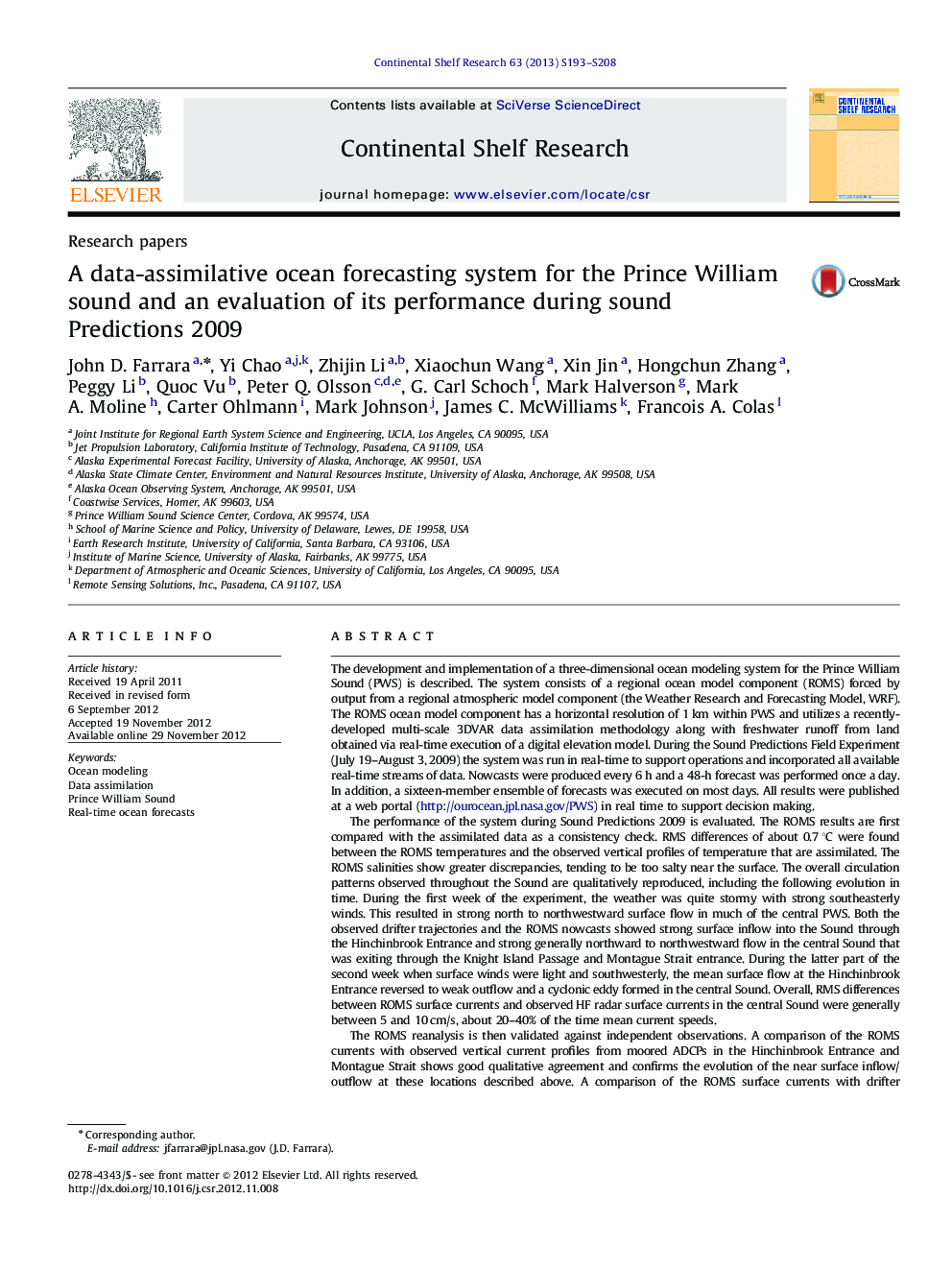| کد مقاله | کد نشریه | سال انتشار | مقاله انگلیسی | نسخه تمام متن |
|---|---|---|---|---|
| 4532091 | 1325093 | 2013 | 16 صفحه PDF | دانلود رایگان |

The development and implementation of a three-dimensional ocean modeling system for the Prince William Sound (PWS) is described. The system consists of a regional ocean model component (ROMS) forced by output from a regional atmospheric model component (the Weather Research and Forecasting Model, WRF). The ROMS ocean model component has a horizontal resolution of 1 km within PWS and utilizes a recently-developed multi-scale 3DVAR data assimilation methodology along with freshwater runoff from land obtained via real-time execution of a digital elevation model. During the Sound Predictions Field Experiment (July 19–August 3, 2009) the system was run in real-time to support operations and incorporated all available real-time streams of data. Nowcasts were produced every 6 h and a 48-h forecast was performed once a day. In addition, a sixteen-member ensemble of forecasts was executed on most days. All results were published at a web portal (http://ourocean.jpl.nasa.gov/PWS) in real time to support decision making.The performance of the system during Sound Predictions 2009 is evaluated. The ROMS results are first compared with the assimilated data as a consistency check. RMS differences of about 0.7 °C were found between the ROMS temperatures and the observed vertical profiles of temperature that are assimilated. The ROMS salinities show greater discrepancies, tending to be too salty near the surface. The overall circulation patterns observed throughout the Sound are qualitatively reproduced, including the following evolution in time. During the first week of the experiment, the weather was quite stormy with strong southeasterly winds. This resulted in strong north to northwestward surface flow in much of the central PWS. Both the observed drifter trajectories and the ROMS nowcasts showed strong surface inflow into the Sound through the Hinchinbrook Entrance and strong generally northward to northwestward flow in the central Sound that was exiting through the Knight Island Passage and Montague Strait entrance. During the latter part of the second week when surface winds were light and southwesterly, the mean surface flow at the Hinchinbrook Entrance reversed to weak outflow and a cyclonic eddy formed in the central Sound. Overall, RMS differences between ROMS surface currents and observed HF radar surface currents in the central Sound were generally between 5 and 10 cm/s, about 20–40% of the time mean current speeds.The ROMS reanalysis is then validated against independent observations. A comparison of the ROMS currents with observed vertical current profiles from moored ADCPs in the Hinchinbrook Entrance and Montague Strait shows good qualitative agreement and confirms the evolution of the near surface inflow/outflow at these locations described above. A comparison of the ROMS surface currents with drifter trajectories provided additional confirmation that the evolution of the surface flow described above was realistic. Forecasts of drifter locations had RMS errors of less than 10 km for up to 36 h. One and two-day forecasts of surface temperature, salinity and current fields were more skillful than persistence forecasts. In addition, ensemble mean forecasts were found to be slightly more skillful than single forecasts. Two case studies demonstrated the system’s qualitative skill in predicting subsurface changes within the mixed layer measured by ships and autonomous underwater vehicles. In summary, the system is capable of producing a realistic evolution of the near-surface circulation within PWS including forecasts of up to two days of this evolution. Use of the products provided by the system during the experiment as part of the asset deployment decision making process demonstrated the value of accurate regional ocean forecasts in support of field experiments.
► ROMS-based data assimilating forecast system applied to 2009 PWS field experiment.
► Evolution of the circulation patterns during the experiment qualitatively reproduced.
► ROMS trajectories compare well with observed drifter trajectories.
► Two-day forecasts of surface quantities are more skillful than persistence forecasts.
► This success demonstrates system’s potential utility for future oil spill responses.
Journal: Continental Shelf Research - Volume 63, Supplement, 15 July 2013, Pages S193–S208